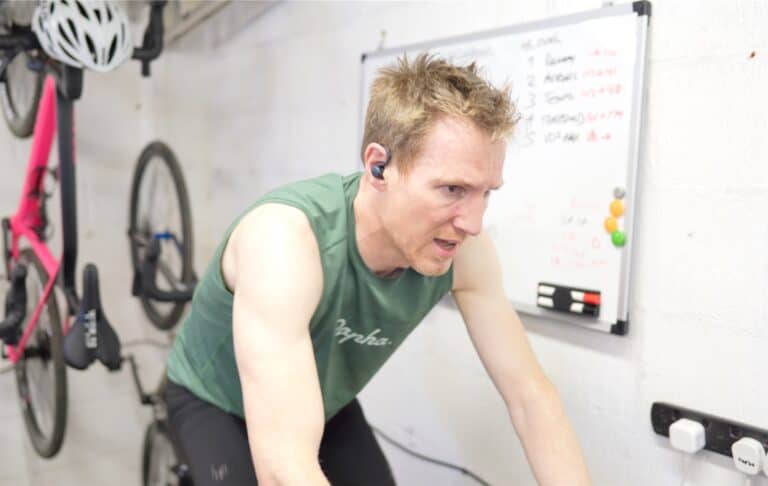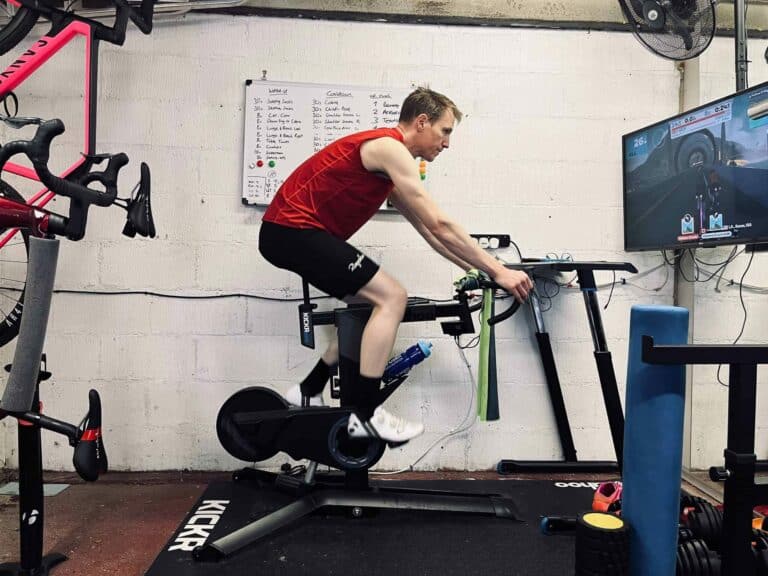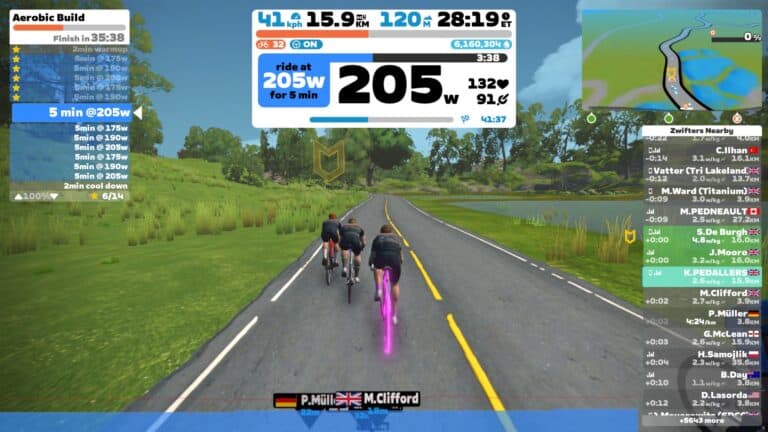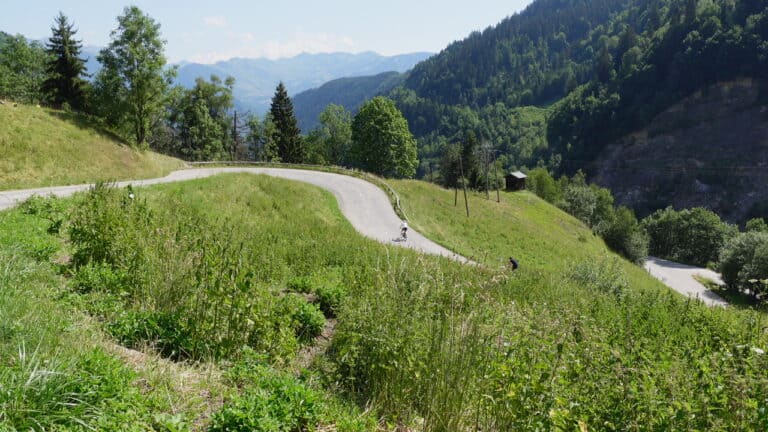When my children were small, I spent most of my cycling time indoors, on my bike trainer and rollers. It was a necessary part of working out since I couldn’t leave my kiddos to get out and train.
And while I love getting outside to ride every chance I get, there are benefits to riding inside on a trainer, too. What’s the difference? And which is better for our health?
In this article, I will talk about the difference between indoor and outdoor cycling. Then, I’ll review the benefits and drawbacks and tell you what I think is better for your health.
Key Takeaways: Indoor Vs Outdoor Cycling
- Indoor training is great when the weather is bad, it’s dark out, or you must be home for your family. Indoor training helps you dial in your workouts to hit specific power or heartrate targets
- Outdoor training improves brain function, recruits more muscles, and improves balance and coordination
- When you train indoors, you might mentally check out, and you miss opportunities for travel, fresh air, and more comprehensive muscle recruitment
- When you train outdoors, you have to be careful of traffic, road hazards, and mechanical issues
- Both types of training are great for getting in shape, weight loss, improved cardiovascular health, and stress reduction

The Benefits of Cycling
There are so many benefits to cycling (both indoors and out), but here are just a few:
- Increases muscular and physical endurance
- Assists weight loss
- Is low impact (easy on the joints)
- Improves both strength and cardiovascular systems
- Reduces stress
- It can be done indoors or outdoors
- Improves balance and coordination
- Enhances brain function
In short, cycling is an excellent exercise because it works both your muscles and cardiovascular system while being easy on the joints. It reduces stress and can help improve balance and critical thinking.
With so many benefits, you might wonder indoor vs outdoor cycling, which is better. Let’s talk about it.

Benefits of Indoor Cycling
You can train when you can’t get outdoors.
Indoor cycling allows you to train even when the weather is bleak. Of course, riding in a snowstorm, on icy roads, or in a heavy downpour isn’t safe, but you can still train indoors in bad weather.
On the other hand, if you have small children or a busy work schedule (or both), you can hit the trainer when it’s dark outside or still be available to your family while squeezing in a workout.

You can ride with people all over the world.
Using a platform such as Zwift or RGT, you can connect with riders worldwide in real-time. Riding with some friends – even virtual ones- is much more motivating!
Keep-together features allow you to ride the same pace while doing individual workouts, so it’s okay if your power numbers don’t match theirs. Sometimes you even can ride with pro cyclists and interact with them. You can chat, race, or ride along at your own pace.

You can dial in your workouts.
Let’s face it, as much as we love riding outside. Nothing beats a trainer for dialing in very specific workouts. Your trainer will set your power targets for you; you have to match your effort to your trainer.
You don’t have to worry about changing gears, dodging traffic, or finding flat roads to optimize your workout.
This is great for those HIIT workouts, interval training, or even making sure you are riding at an easy pace while doing a simple recovery ride.
You can binge-watch your favorite shows.
Need to catch up on your fav Netflix? Want to watch the news? You can watch movies, play games on your phone, listen to loud music, or even read when riding the trainer – but you can’t do that outside.
Bonus, it helps distract you from the pain in your legs when working hard.
Benefits of Outdoor Cycling
Fresh air and sunshine.
Getting outdoors is good for us – fresh air, vitamin D, and getting out in nature – all boost our mental health. In addition, there’s so much more to see outside than inside – you get to spend time in nature, see animals, enjoy the breeze, and go places.

You can do errands or stop for coffee while workout out.
Cycling isn’t just a workout – it’s also a way of getting places. You can use your workout time to commute to and from work. You might take the long way, climb the extra hill, or do some intervals on your way home.
You can run errands with your bike, bring home some heavy groceries, or take your kids to school and plan a coffee stop with friends. Cycling outdoors is a fun way to stay active while accomplishing errands and chores.

Better muscle engagement.
You recruit a lot more muscles outside than you do inside. Because the bike moves around more underneath you when you ride outside, you’ll use much more core strength to stay on the bike.
You’ll lean into turns, shouldering bumps in the road and climbing out of the saddle. When you sprint, the bike will naturally swing side to side beneath you, adding another element of balance and control.
You’ll be looking around you, watching for traffic and other cyclists, scanning the road ahead, and looking at the sights around you.
Outdoor cycling is better for your brain and eye health.
Studies show a correlation between spending more time outdoors with a lower correlation of nearsightedness. Scientists think this is a combination of our eyes taking in more light and being able to focus on things that are further away from us. Indoors, we only look at things that are close by.
Cycling helps to increase blood flow to the brain, but cycling outdoors can improve the brain’s function and cognition.
When you ride outdoors, your mind is much more engaged in your activity; you are choosing lines, watching out for hazards, constantly scanning the road, and making micro-decisions about where you are going and what your body is doing.
You have to think quickly and be alert, which makes your brain work harder alongside your muscles. Indoors, we tend to ‘check out’ and let our brains focus on other things.
Drawbacks of Indoor Cycling
Static position means less muscle recruitment.
Indoor training works many muscles, but not as many as outdoors. Since you aren’t constantly adjusting your position on the bike, you’re missing out on opportunities to develop your core muscles, your calves, and even the muscles in your feet.
In addition, you aren’t standing up in the saddle as much, and unless you invest in a Kickr Climb, your bike won’t change position like it would outdoors on hilly terrain.
You don’t get the benefit of hill work.
When you ride indoors, your trainer can mimic the extra effort you need to put out for various hill climbs. However, it isn’t the same as heading up an actual hill and feeling the actual forces of gravity pulling you down.
You’ll need more muscles and more force climbing outdoor hills than indoor ones – so you’ll miss some of the benefits of outdoor hills, especially if you are doing hill repeats.
Indoor cycling can get tedious.
I’ll be the first to admit that indoor riding, as much as I love it, can get very tedious. A lengthy zone 2 ride is great for building mitochondria and building strength without building fatigue – but riding on a trainer for two hours at the same watts can get very boring.
Your muscles and low back can get stiff and sore from being in the same position. And it just lacks the excitement you would find on an outdoor fun ride.
You aren’t working on your bike handling skills.
My first outdoor ride of the season always feels a bit sketchy. The bike feels twitchy, and it is a lot more fatiguing after having been on the trainer all winter. Why is this? Well, first of all, you can’t work on your bike handling skills on a trainer. You can’t practice leaning into or apexing a turn.
You aren’t learning balance, steering, or choosing your line.
It’s really easy to sit up and spin on a static bike trainer, but sitting up and spinning outdoors takes a lot more balance, skill, and smooth pedaling. So when you spend a lot of time on the trainer, your IRL bike handling skills can take a big hit.
You’ll want to remember this when you hit the road for the first time – and be especially careful around traffic and road hazards.
It’s hot.
When you ride outdoors, the faster you go, the more wind you feel. All that wind helps you feel cool while evaporating your sweat and whisking away heat. But there’s no wind indoors.
Indoor training is especially hot and sweaty since there isn’t any air movement to cool you down. You’ll need to invoke some pretty mighty fans to cool you off while you ride indoors.
Large fans can be noisy, so you’ll need to crank up your tunes even louder (much to the dismay of your family and neighbors).

You’re checked out.
It’s easy to check out on an indoor ride. However, whether you are on a stationary bike or bike trainer, your brain doesn’t have to pay attention since you don’t have to look where you’re going, and your bike or trainer does the hard work of setting resistance for you.
You’re less mentally engaged in your workout, so you might not be working as efficiently as you otherwise could. As a result, you may end up ‘biding your time’ on the trainer rather than putting a solid effort in.
Drawbacks of Outdoor Cycling
Bad weather can stall your workout.
Of course, if you’re planning an outdoor workout and a sudden storm hits, you aren’t going to be able to get that workout done. You may end up doing it later or not at all. The weather can be unpredictable and bad, so you either suffer through it or skip it altogether.
Traffic can be a real downer.
Traffic lights and stop signs may interrupt your intervals. Running red lights and stop signs can be dangerous and get you a ticket – even on a bike.
But if you’re trying to do an interval workout in your town, you may have to work around traffic patterns, red lights, and stop signs to get your workout done.
You may be in the middle of a sprint session and have to pause for a crossing train. Or maybe you’re trying to do a long Zone 2 ride but find you are constantly stopping at stop signs for passing cars. Traffic can interrupt a good workout plan, making it hard to get your best efforts in.
You can have mechanical issues.
Flat tires, broken spokes, and other mechanical issues can derail your workout faster than a derailleur can shift your gears. So it’s a downer when you head out for a solid workout and get stuck with a flat somewhere or have to pause your efforts to patch up a tube.
Being prepared for minor mechanical issues can prevent you from having to Uber your way home, but it still won’t fix the interruption to your workout.
You might be worried about safety.
As a petite woman, I’ve been followed on my bicycle more than once. And while I feel safe in most places I ride, I think twice when I head out on a solo workout ride.
Riding alone, riding in high-traffic areas, or being out on lonely roads can worry you about your safety. If you can’t workout with a group, you might feel better inside on a stationary bike or trainer.
You need to plan routes.
It’s easy to get lost when you’re out on your bike. You’ll want to invest in an app such as Strava or Ride with GPS to help you plan routes for your workout that fit your time constraints and help you meet your fitness goals.
Depending on your workout plan for the day, you’ll want to find less busy roads which are flat or inclined.
Final Thoughts on Which Is Better for Your Health: Indoor Vs. Outdoor
We’ve looked at the pros and cons of riding indoors and outdoors – and there is a lot for both sides of the spectrum. So which is better?
In my opinion, the answer is both. I love my trainer for the safety, the chance to ride even when my kids are around, and for dialing in tough workouts. But I also love riding outside for the fresh air and endorphins, the bike handling skills, and the sheer fun.
If you have the resources, there’s no reason to choose one or the other. So instead, do both, depending on the weather, your safety, and the type of workout on your schedule. You can tailor your ride to what needs to be done for the day.
What type of riding do you prefer? Do you like indoor or outdoor workouts or both? Let us know in the comment section.
Frequently Asked Questions
Is outdoor cycling better than indoor?
Outdoor cycling offers the advantages of fresh air, scenic routes, and real-world challenges, making it a great choice for those who enjoy exploration and varied terrain.
Indoor cycling, on the other hand, provides a controlled and consistent environment, making it ideal for structured training programs and all-weather convenience.
Is it harder to ride indoors or outdoors?
Indoors, it may feel harder, and you may be dialing in your intensity. However, outdoors you are probably working harder, using more muscles, and creating more fatigue when climbing actual hills, leaning into turns, and using more core muscles.

Do you burn as many calories outdoors as you do indoors?
Generally speaking, your calorie burn is calculated using the numbers from your power meter, or it might be extrapolated from your heart rate. These numbers don’t take into consideration whether you are indoors or outdoors.
However, when you ride outdoors, you may use more muscles differently, which could mean higher calorie burn.
Can you ride outside in the cold?
Average cyclists tend to ride outside only if the temperature is above 40 to 45 degrees Fahrenheit or 4 degrees Celsius. However, if you have the right clothing and gear and are comfortable, you can ride outside when it is colder.
